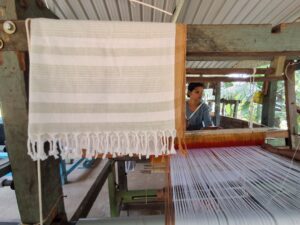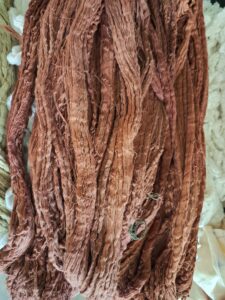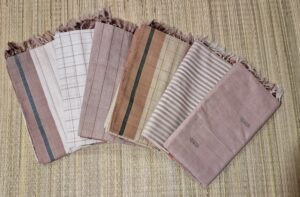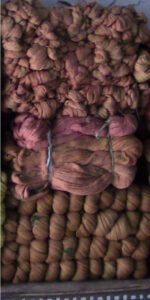
Mamatha Rai started the use of natural dyes to make Udupi sarees more sustainable. (Supplied)
Among the different kinds of industrial activity, the textile industry is one of the leading pollutants of water and soil. Chemical dyes, especially, not only utilise a large quantum of water but also release an array of harmful chemicals and metals like lead, cadmium and chromium into the environment.
The garment industry is responsible for close to 10% of the global carbon emission. So the importance of using sustainable and natural dyes can hardly be overemphasised. But one person who has been pioneering the use of natural dyes ever since she took up the project of reviving the GI-tagged Udupi saree is Mamatha Rai, president of Kadike Trust.
The history of the Udupi sarees dates back to 1844 and while the craft flourished for over a century, the late 1990s saw a sharp decline in the number of weavers due to the advent of power looms.

Areca border stoles. (Supplied)
With just 45 weavers left in the districts of Dakshina Kannada and Udupi in 2018, the Trust took up the initiative of reviving this handloom legacy. With a single-minded focus and relentless dedication, Rai and her team have not only managed to increase the number of weavers to 72 in both districts but also trained young people and motivated them to become weavers.
Weavers, who had quit the profession, have also returned. Besides, the average age of the weavers has also reduced substantially.
Being a champion of eco-friendly practices, Rai also started the use of natural dyes to make the end product more sustainable.
“We started with the use of natural dyes in 2018, and mainly began with indigo and madder root. We also used marigold petals and pomegranate peels and acacia catechu. The latter was used to obtain deep brown-red shades,” adds Rai.
Rai was always aware of the use of areca nut dye as she was a customer of the fabrics made by Charaka — a women’s cooperative society in the Bheemanakone village of Karnataka.

Areca dyed yarns. (Supplied)
The latter makes extensive use of areca nuts for dyeing.
“Since last year, there has been a lot of awareness about the benefits of areca nut dye especially due to the efforts of Shree Padre sir, the editor of the Adike Patrike. We got a lot of contacts from him to obtain the areca nut syrup aka chogaru, which is the base for the dye. We finally opted for chogaru powder from Srinivas Moorthy, who is a farmer from Shringeri,” elaborates Rai.
The first batch of areca nut-dyed sarees was launched at the end of July this year. Preparations are on to manufacture the second set of sarees soon.
India is the largest producer and consumer of areca nut, which is commonly called supari or betel nut. Botanically called Areca catechu, this palm is also grown in tropical Pacific and Asia.
The areca nut dye in question is derived as a result of processing young red areca nuts which are harvested, peeled, boiled and sundried. The dark red liquid that is left over after the nuts are boiled is locally called adike chogaru/thogaru. It tends to thicken over time, and if left for a longer period, the tannin-rich chogaru crystallises.

Areca sarees. (Supplied)
An expert dyer herself, Rai explains that the process of dyeing the yarn using areca is elaborate. It requires one to be meticulous about parameters like PH, temperature etc.
The yarn is first cleaned off all impurities and then washed and treated with soda ash and soap nut solution, which is left overnight and then washed.
The next step is the addition of the mordant or dye fixative after which the yarn is soaked in areca chogaru solution. The latter is prepared by mixing areca chogaru powder in water and heating the mixture to about 80 degrees centigrade.
After the yarn is soaked, wood ash water or little potassium hydroxide is added to maintain the PH at 10. It is left overnight after which it is washed and hung dry. The areca chogaru dye is known to produce alluring shades of brown, pink, garnet and maroon.
The first batch of over 35 areca-dyed sarees was manufactured in a variety of designs and combinations. It included motifs, checks, stripes and even contrast borders of indigo and manjisthta.
The response was overwhelming and all sarees were prebooked and sold out within a short period. The sarees are priced from ₹2300 to ₹4,400.

Different shades of areca dyed yarns. (Supplied)
While Rai has played a pivotal role in the dyeing of these sarees, she has also been conducting workshops and training programs through the Trust about using this planet-friendly dye.
The Trust recently organised a training programme for the youth (some of them belonging to tribal communities) of Hoseri, a hamlet in Yelajith village in Byndoor taluk. Under this programme, six months training will be imparted with a stipend for hand weaving areca dyed stoles, shawls, towels and lungis.
While bookings have already been made for the next batch of areca-dyed sarees, the manufacturing is also fraught with challenges.
It includes the large amount of time required for the yarn to be naturally dyed which is typically 7-8 days before it is ready for weaving. The gross shortage of experienced dyers and a dedicated facility for bulk dyeing of yarn are also challenges.
Although they have received support from SELCO in terms of equipment like solar powered water boilers etc, large-scale dyeing of yarn, according to Rai, is still a challenge.
There are several advantages of using areca dye as it is a natural and sustainable dye. It is a farm by-product which means it helps provide additional income to farmers.
“Also, while using areca, the dye bath can be used multiple times to create different shades of brown and pink. This reduces the consumption of water and dye materials. The water used during dyeing can be reused for irrigation and washing,” adds Rai.
Since the entire procurement and process of natural dyeing is done by them, Rai’s team can compensate the weavers more. “The effect that chemical dyes have on the environment can be detrimental. So it is the responsibility of each one of us to support organizations using natural dyes,” concludes Rai.

Jul 26, 2024

Jul 26, 2024

Jul 26, 2024

Jul 26, 2024

Jul 26, 2024

Jul 25, 2024